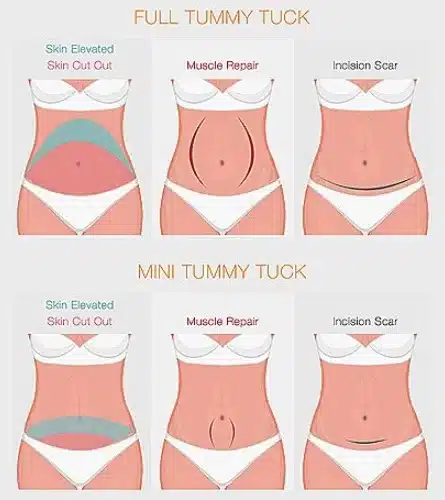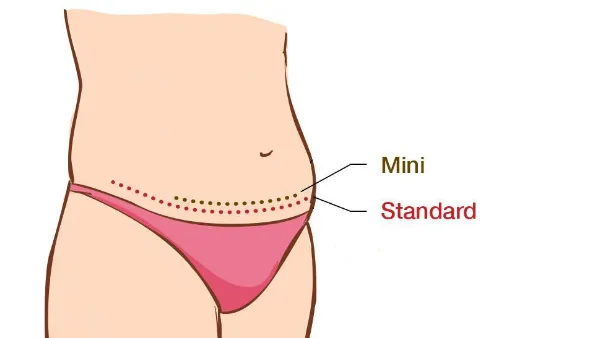Introducing mini abdominoplasty, commonly known as a tummy tuck, a popular cosmetic surgery procedure focused on enhancing body contouring in the lower abdomen. This less invasive alternative to traditional abdominoplasty targets localized areas of excess skin and fat, offering patients a streamlined approach to achieve their aesthetic goals. Mini abdominoplasty represents a transformative option within the realm of cosmetic surgery, providing individuals with a tailored solution for refining their abdominal appearance and boosting confidence.
Different Types of Mini Abdominoplasty
Unlike a full abdominoplasty involving a longer incision and more extensive tissue manipulation, mini abdominoplasty addresses specific concerns in the lower abdomen. This procedure is prevalent among individuals who have experienced pregnancy or weight loss, as it can help tighten and tone the area for a more sculpted and youthful appearance.
There are a few different variations of mini abdominoplasty that can be tailored to meet individual patient needs. These include:
Abdominoplasty, commonly known as a tummy tuck, is a transformative cosmetic surgery aimed at enhancing abdominal contouring. This procedure targets excess skin and fat, tightening abdominal muscles to achieve a flatter, more toned appearance. With its focus on aesthetic refinement, abdominoplasty remains a popular choice for those seeking to sculpt their midsection.
Mini Traditional Abdominoplasty
This technique involves a small horizontal incision above the pubic area, allowing the surgeon to remove excess skin and fat and tighten the underlying muscles.
Clinic contact number: +989371200167
Mini Abdominoplasty
This procedure focuses on addressing excess skin and fat in the lower abdomen, typically below the belly button. It involves a smaller incision and targets a more localized area compared to traditional abdominoplasty. Mini abdominoplasty is ideal for patients with mild to moderate skin laxity and muscle separation in the lower abdomen.
Traditional Abdominoplasty
Traditional abdominoplasty, also known as a full or standard tummy tuck, addresses excess skin and fat throughout the entire abdominal area, both above and below the belly button. It often involves a longer incision, muscle tightening, and repositioning of the belly button to achieve a flatter and more contoured abdomen. This procedure is suitable for patients with more significant skin laxity and muscle separation, such as those who have undergone significant weight loss or multiple pregnancies.
Mini Fleur-de-Lis Abdominoplasty
This procedure is suitable for patients with significant skin laxity and requires vertical tightening in addition to the horizontal tightening performed in traditional mini abdominoplasty. It involves an additional vertical incision along the midline of the abdomen.
Mini Extended Abdominoplasty
This technique addresses the lower abdomen and the flanks. It involves longer incisions extending beyond the hip bones, allowing for more extensive waistline contouring.
The type of mini abdominoplasty recommended for a patient will depend on their anatomy and aesthetic goals. A consultation with a board-certified plastic surgeon is essential to determine the most suitable approach.
Mini Abdominoplasty: Step by Step
The mini abdominoplasty procedure generally follows these steps:
- Anesthesia: The surgeon will administer either general anesthesia or local anesthesia with sedation to ensure the patient’s comfort throughout the procedure.
- Incision: A small horizontal incision is made above the pubic area, typically low enough to be concealed by underwear or a bikini bottom. Sometimes, an additional incision may be made vertically in the midline, depending on the chosen technique.
- Tissue manipulation: The surgeon carefully lifts the skin and underlying tissue to gain access to the abdominal muscles.
- Muscle tightening: If necessary, the surgeon will tighten the abdominal muscles by suturing them together, resulting in a firmer and flatter abdomen.
- Skin and fat removal: Excess skin and fat are removed from the lower abdomen, achieving a smoother and more toned appearance.
- Incision closure: The incisions are meticulously closed using sutures or surgical staples.
- Drain placement: In some cases, drains may be placed to remove excess fluid from the surgical site and promote healing.
- Dressing application: The surgeon will apply dressings and possibly a compression garment to support the healing process and reduce swelling.
The length of the procedure may vary depending on the extent of correction required and the specific technique chosen.

10 Benefits of Mini Abdominoplasty
Mini abdominoplasty offers several benefits to individuals seeking abdominal contouring. These advantages include:
- Improved abdominal appearance: Mini abdominoplasty can provide a flatter, more toned lower abdomen by removing excess skin and fat.
- Enhanced self-confidence: Many patients experience a boost in self-esteem and body image following the procedure, as they feel more comfortable and confident in their appearance.
- Reduced stretch marks: The removal of loose skin during mini abdominoplasty can minimize the appearance of stretch marks on the lower abdomen.
- Increased clothing options: Patients often find that their clothing fits better and have a more comprehensive range of wardrobe choices after mini abdominoplasty.
- Corrected muscle separation: For individuals with mild muscle separation, abdominoplasty can help tighten and repair the abdominal muscles, improving core strength.
- Quicker recovery than a full abdominoplasty: The less invasive nature of mini abdominoplasty generally leads to a shorter recovery period, allowing patients to return to normal activities sooner.
- Less scarring: abdominoplasty typically involves a smaller incision, resulting in less noticeable scarring than a full abdominoplasty.
- Minimal disruption of the naval position: Unlike a full abdominoplasty, mini abdominoplasty does not typically require repositioning of the belly button, resulting in a more natural-looking result.
- Targeted correction: abdominoplasty explicitly addresses the lower abdomen, making it ideal for individuals with excess skin and fat.
- Long-lasting results: With proper maintenance and a healthy lifestyle, the results of mini abdominoplasty can be long-lasting, allowing patients to enjoy their improved abdominal contour for years to come.
Mini tummy tucks are typically considered safe. However, risks include infection, irregular scarring, or fluid accumulation under your skin.Health Line

Risks of Mini Abdominoplasty
As with any surgical procedure, there are potential risks and complications associated with mini abdominoplasty. These risks include:
- Bleeding: Excessive bleeding during or after the procedure can occur, although it is relatively rare.
- Infection: There is a risk of infection at the incision site, which can be minimized with proper postoperative care and antibiotic use.
- Poor wound healing: Sometimes, the incision site may heal slowly or poorly, resulting in broader or more visible scars.
- Seroma formation: Seromas, or fluid collections, can develop under the skin, leading to swelling and discomfort. Drains are often used to minimize this risk.
Discussing these risks with a qualified plastic surgeon during the consultation is essential to understand the potential complications of mini abdominoplasty.
Clinic contact number: +989371200167
Innovations and Insights from Prominent Figures and Institutions
Mini abdominoplasty surgery, a less invasive alternative to traditional abdominoplasty, has garnered attention from prominent figures in the field of plastic surgery, including Dr. Foad Nahai from Emory University School of Medicine and Dr. Grant Stevens from the University of Southern California. Their extensive research and contributions to the field have helped refine techniques and improve outcomes for patients undergoing mini abdominoplasty procedures. Additionally, institutions like the Mayo Clinic and Cleveland Clinic have been at the forefront of advancing surgical techniques and patient safety protocols in the realm of body contouring surgeries, including mini abdominoplasty.
In recent years, mini abdominoplasty has seen a rise in popularity, with statistics from the American Society of Plastic Surgeons (ASPS) indicating a notable increase in the number of procedures performed annually. This trend reflects the growing demand for less invasive options in body contouring surgery, particularly among patients seeking to address localized excess skin and fat in the lower abdomen. With advancements in surgical technology and techniques, coupled with the expertise of skilled surgeons, mini abdominoplasty continues to offer patients effective solutions for achieving a more toned and contoured abdominal appearance with reduced recovery time and risk of complications.
What Should You Do Before Mini Abdominoplasty
Before undergoing abdominoplasty surgery, it is essential to take specific steps to ensure a successful procedure and smooth recovery. Here are some important considerations:
- Choose a qualified plastic surgeon: Research and select a board-certified plastic surgeon with extensive experience performing abdominoplasty. Review their qualifications, credentials, and patient reviews to make an informed decision.
- Schedule a consultation: Meet with your surgeon to discuss your goals, medical history, and expectations. This will allow the surgeon to evaluate your suitability for abdominoplasty and recommend the most appropriate technique.
- Follow preoperative instructions: Your surgeon will provide specific guidelines to prepare for the procedure, such as avoiding certain medications, quitting smoking, and arranging for someone to drive you home after surgery.
- Complete medical evaluations: Before surgery, you may need to undergo various medical evaluations, including blood tests, imaging, and a physical examination, to ensure you are in good health for the procedure.
- Arrange for postoperative care: Plan for a designated caregiver to assist you during the initial recovery days, as you may require help with daily activities and wound care.
- Prepare your home: Create a comfortable recovery space at home with essential supplies, medications, and a designated resting area. Ensure your home is clean and free from any potential hazards.
- Arrange time off work: Plan for an adequate period off work or other responsibilities to allow for proper rest and recovery.
- Maintain a healthy lifestyle: Leading up to the procedure, focus on maintaining a healthy diet, exercising regularly, and avoiding significant weight fluctuations. These habits will promote optimal healing and long-term results.
Following these preoperative recommendations can maximize the chances of a successful outcome and minimize potential complications.

Conclusion
In summary, mini abdominoplasty stands as a valuable option within the realm of cosmetic surgery, offering patients a less invasive approach to body contouring in the lower abdomen. Through targeted removal of excess skin and fat, mini abdominoplasty aims to sculpt and refine the abdominal area, providing individuals with a streamlined path to achieving their desired aesthetic goals. With advancements in surgical techniques and scar minimization strategies, patients can expect reduced recovery times compared to traditional abdominoplasty, allowing for quicker return to daily activities and enhanced overall satisfaction with the procedure.
As with any cosmetic surgery, thorough consultation with a qualified plastic surgeon is crucial to ensure that mini abdominoplasty is the right option for each individual patient. By discussing expectations, assessing candidacy, and outlining the specifics of the procedure, patients can make informed decisions and embark on their journey toward a more contoured and confident physique. With a focus on surgical precision, personalized care, and patient satisfaction, mini abdominoplasty continues to be a transformative solution in the realm of body contouring and cosmetic surgery.
Clinic contact number: +989371200167
FAQs
How long is the recovery period after mini abdominoplasty?
The recovery period after mini abdominoplasty can vary depending on the individual and the extent of the procedure. Generally, patients can expect around two to four weeks to recover.
Can mini abdominoplasty address stretch marks?
Yes, mini abdominoplasty can help minimize the appearance of stretch marks on the lower abdomen.
What is the difference between mini abdominoplasty and traditional abdominoplasty?
Mini abdominoplasty targets a smaller area of the abdomen, primarily focusing on the area below the belly button. In contrast, traditional abdominoplasty addresses excess skin and fat throughout the entire abdominal region and may involve muscle tightening. Mini abdominoplasty generally results in shorter incisions and a quicker recovery time compared to traditional abdominoplasty.
What can I expect during recovery from mini abdominoplasty?
Recovery from mini abdominoplasty typically involves some discomfort, swelling, and bruising, which can be managed with prescribed pain medications and proper post-operative care. Most patients can resume light activities within a few weeks, but it may take several months for full recovery and final results to become apparent.
Are there risks or complications associated with mini abdominoplasty?
Like any surgical procedure, mini abdominoplasty carries potential risks and complications, including infection, bleeding, poor wound healing, and adverse reactions to anesthesia. However, the risks may be lower compared to traditional abdominoplasty due to the less invasive nature of the procedure. It’s essential to discuss potential risks with your surgeon and follow pre and postoperative instructions carefully to minimize complications.
Mini Tummy Tuck: Cost, Procedure, and More (healthline.com)



